I’ve wanted for some time to document the 41 Peg track that follows an old bridle track from Tomahawk Lagoon up to Highcliff Road, but have been beset by doubts that it’s not interesting enough for a full post. Luckily, the Wellness Walkers Trust decided to combine this walk with one I’d done with Dad way back in October 2015: The Karetai Track. Now I was certain to have enough new material to justify my effort.
We gathered at the Tomahawk Lagoon, a vision of paradise populated by waterfowl, with swans and their cygnets cruising around the azure waters. We watched, captivated, as one of the fuzzy grey babies climbed on to its mother’s back for a ride.

Then it was time for us to set off – through a forested tunnel around the lagoon and to the green hills beyond. A quick scramble over a stile and through the trees brought us to a fence line running toward the top of the ridge overlooking the lagoon. Luckily the ever-improving view of the wetlands and ocean below gave us ample excuse to stop and rest as we slogged up the hill.
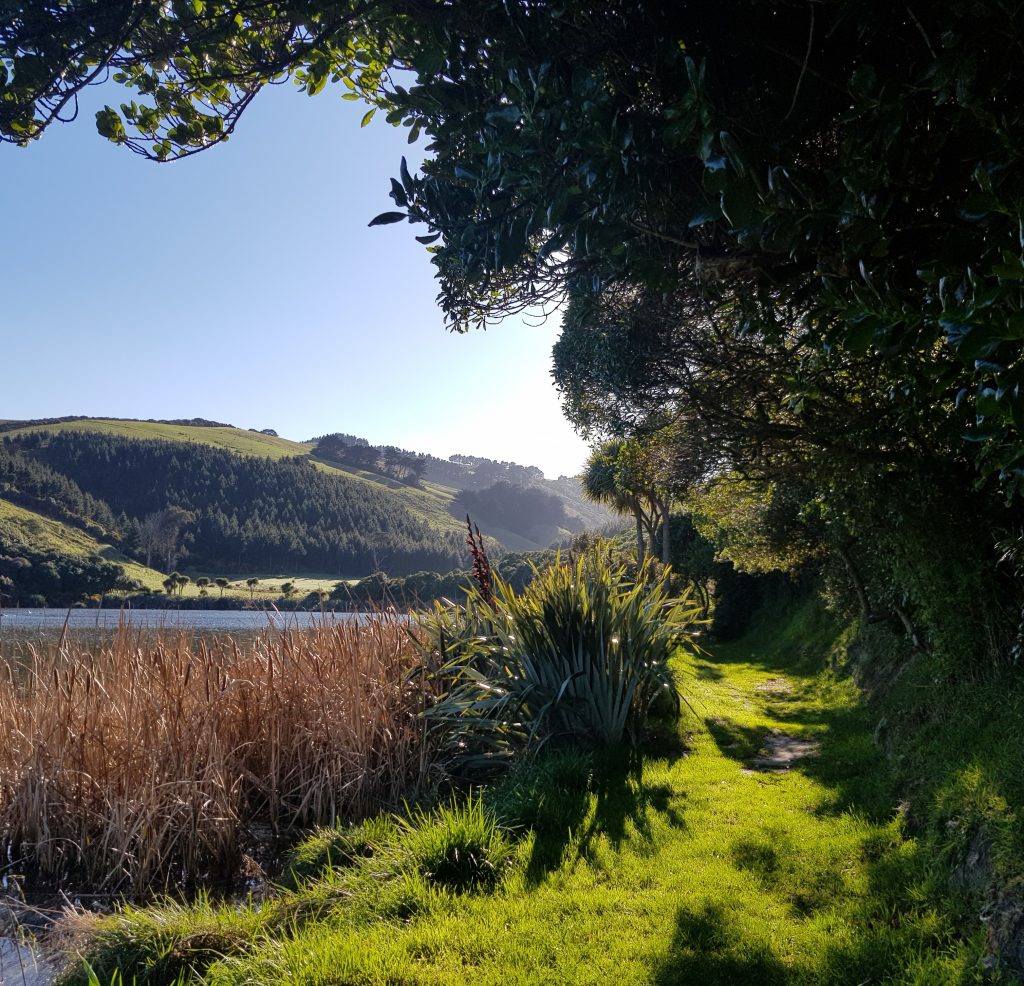
Here the track takes a ninety degree turn to follow the ridge straight up toward Highcliff Road. It’s a stiff climb through unruly grass and rampant gorse on either side. There are the remains of dry stone walls here but few indications of nearby homesteads on the old maps of the area.
As I climbed, I contemplated the unusual name of this track. It was easy to assume that “41 Peg Road” refers to a street address, however there’s no evidence that “Peg Road” ever existed. The few mentions of it in old road board meeting minutes refer to it as “the 41 peg road”. Even the DCC Archivist wasn’t sure, but suggested that what started as an unofficial name used by local landowners may be a reference to a surveying mark of some kind.
Further pondering was cut short by our first glimpse of the Otago Peninsula Fallen Soldiers’ Memorial – a welcome sight for those of us who were beginning to think the steep climb would never end.
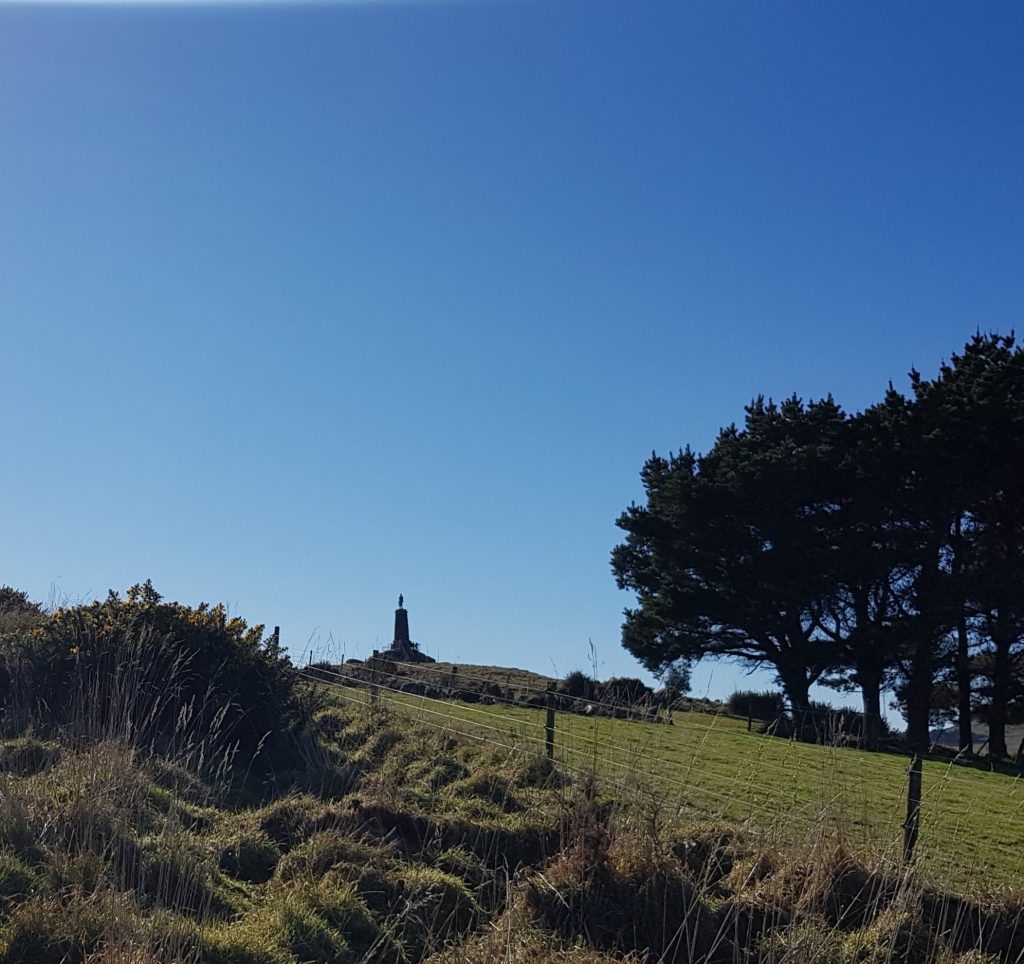
We made our way up to what was once known as Cadzow Hill, Rocking Boulder, or the Big Stone, and which was renamed Arthur’s Seat shortly before the memorial was unveiled in 1923 to commemorate the men of the Peninsula who lost their lives in the First World War. The original plaque had some errors – not uncommon for memorials of the time – and after painstaking research by historian Ron Palenski, a corrected version was installed in 2015.
The now-accurate plaque is sobering reading. There are names familiar to Peninsula historians, families we have got to know through the signs they have left. Among them are seven sets of siblings.

Though I could stand here and tell each story in turn, my focus was drawn to a name that matched the track that we would be descending by, a name slightly different from the others. It seems Private Stewart Karetai was great-grandson of the renowned rangatira Karetai who resided at Otakau during the dawn of European contact in New Zealand.
In the past I wouldn’t have thought twice about seeing this name on a First World War memorial, but the more I’ve learned about early history between Māori and Pakeha, the more wondrous it seems that any Māori would be willing to put their life on the line for an Empire that had treated them with such bad faith.

It turns out some Māori of the time thought the same way. In 1915, an E. Karetai wrote in to the Otago Daily Times to wonder:
The Maori understands that England has gone to war for honour’s sake – that Germany violated a “scrap of paper,” which her representative had signed for the protection of a small country. So far so good. But the mere Maori mind cannot help asking, where is Britain’s honour? What about the “scrap of paper” Britain signed for the protection of a small people, and the promises contained therein? Why has Britain allowed the New Zealand Government to violate that “scrap of paper,” called the Treaty of Waitangi? Did I hear the Minister say that those injustices were past? No; they live to-day, and will live for ever a blot on New Zealand history, and – shall I say it – on Britain’s honour and her much-vaunted fairplay.
That is not to say that all voices were unanimous, even at Otakou. More than one resident wrote in to decry E. Karetai’s attitude, stating that she was in fact E. Waldsgott, the wife of a trouble-making German:
Hence these tears! Hence the explanation of the letters!
From the date given for Stewart’s death, it appears that he may have been one of the hundred men of the Māori Contingent requested on the evening of 20 August 1915 for an attack the next morning on Hill 60 at Gallipoli. Of the hundred Māori men sent to take part in that costly and ultimately pointless attack, there were 48 or 49 casualties (wounded or killed). This battle took place mere weeks before the remainder of the Māori forces were withdrawn from Gallipoli.
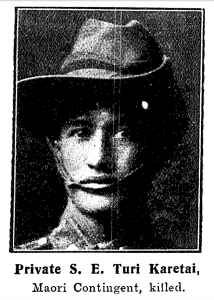
Stewart Karetai, aged 21 years, was killed in action at Gallipoli on 21 August 1915, and he lies there still. His family memorialised him thus:
He rose responsive to his country’s call. He gave his life, his best, his all.
Now was time for us to leave the windy outcrop, with its lone soldier still standing sentinel over the city. We descended to Highcliff Road, looking back to farewell the fallen.

Then we turned our attention back to the present, admiring the sparkling waters of the harbour below as we carefully followed the road. We passed some friendly alpacas and ignored Centre Road (a fairly boring way to return to Tomahawk) before making a hard right at Karetai Road.
The sights here include an impressive art deco house, more dry stone walling, and views over the hills toward South Dunedin. The road ends in a macrocarpa-girt car park before continuing as a foot track.
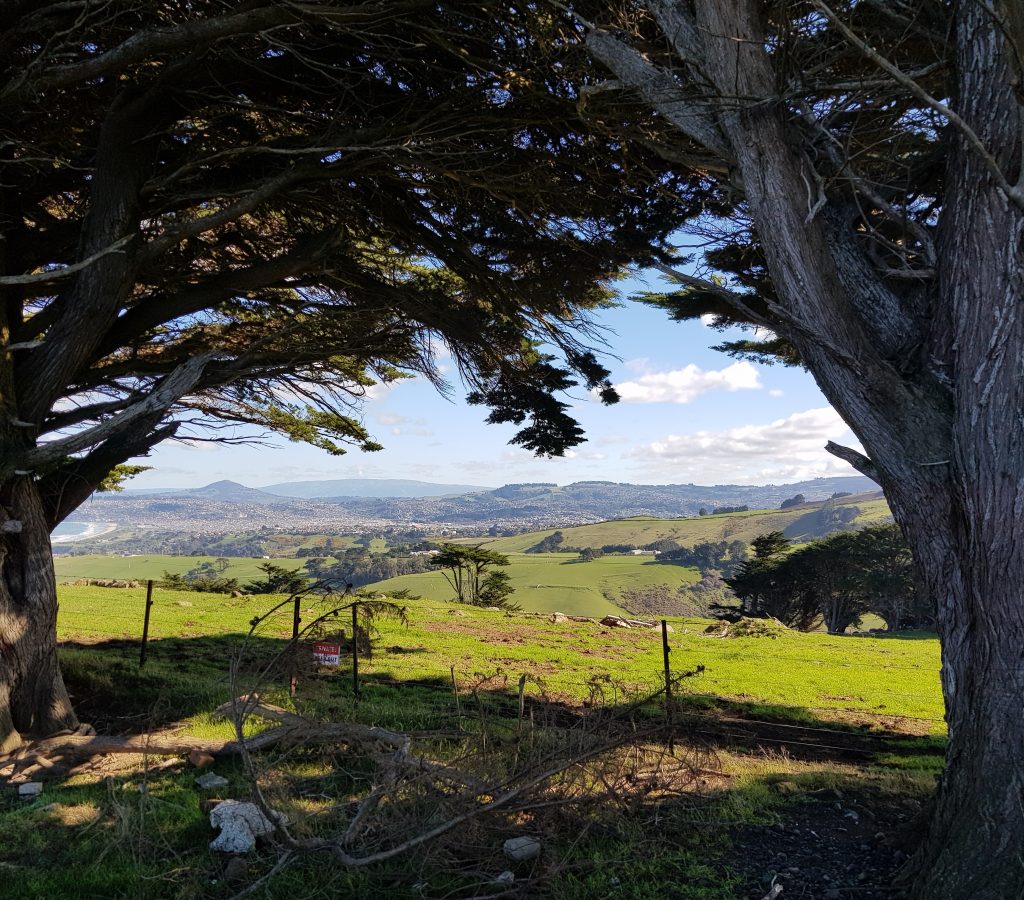
Here again we don’t see much sign of the early settler homesteads, though a crown of macrocarpa just visible over a hill nearby marks the site of “Scotia” – where I’ve heard tell a ruin can be found.
I once again showed my fellow walkers the access to my “secret garden” – the little cliff side overhang at the corner of Karetai Track, from which the spectacular basalt cliffs ranging from here to Boulder Beach can be seen in all their glory.
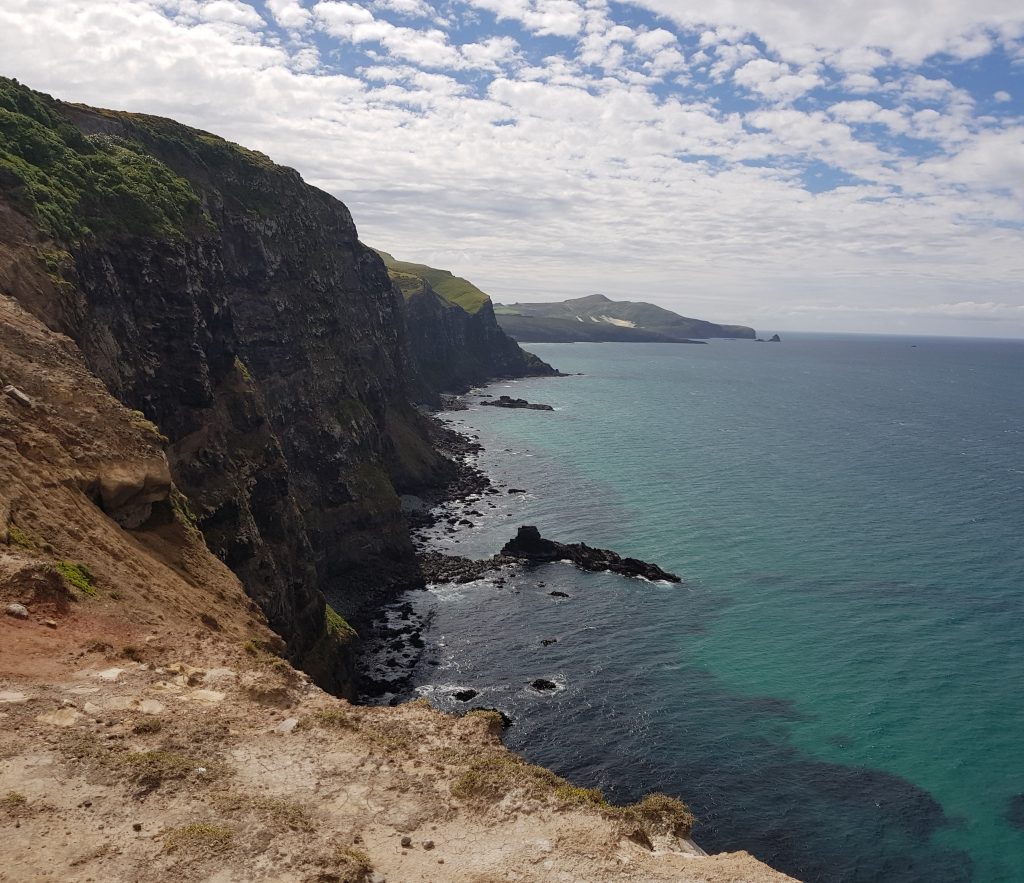
Here we find another mystery of nomenclature, for the place has been known as “Pudneys Cliff” since at least 1901. But I can’t find anyone named Pudney associated with the Peninsula, nor can I find any other reason for the name. Whatever its history, it is a spectacular – if slightly scary – place to stand among the hebe bushes and look down at the ocean, which here looks deceivingly tropical.
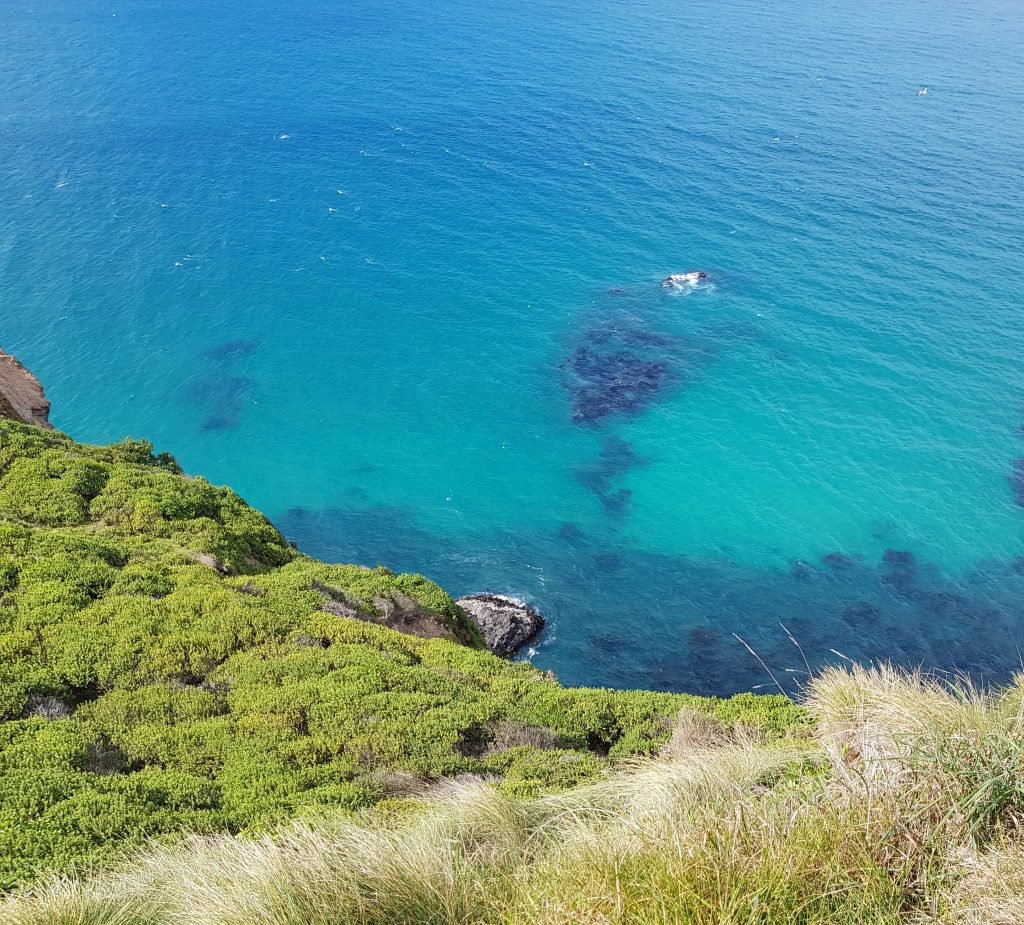
From the cliff the trail turns toward Smaills Beach, eventually passing the impressive residence of Smaill himself, now the Tautuku Fishing Club. Then it was a simple climb over the headland dividing Smaills Beach from Tomahawk Beach before we finally reached our start point.
For my part, I consider the effort entirely justified, although I’ve perhaps unearthed more mysteries than I’ve solved. I’ve walked a familiar trail but gained new knowledge on the way, and doesn’t that make anything worth while?
References:
DCC Archivist Service
In the names of the fallen by Ron Palenski
Rededication for memorial with corrected roll of honour By David Loughrey
OBITUARY Otago Daily Times, Issue 21079, 16 July 1930
MAORI LOYALTY Otago Daily Times, Issue 16481, 6 September 1915
LETTERS TO THE EDITOR Otago Daily Times, Issue 16495, 22 September 1915
Otago Witness, Issue 3206, 25 August 1915, Supplement
Private S. E. Turi Karetai, Maori Contingent, killed. Otago Witness, Issue 3213, 13 October 1915, Supplement
FOR THE EMPIRE’S CAUSE. Otago Daily Times, Issue 18946, 21 August 1923
Māori in the Great War by James Cowan
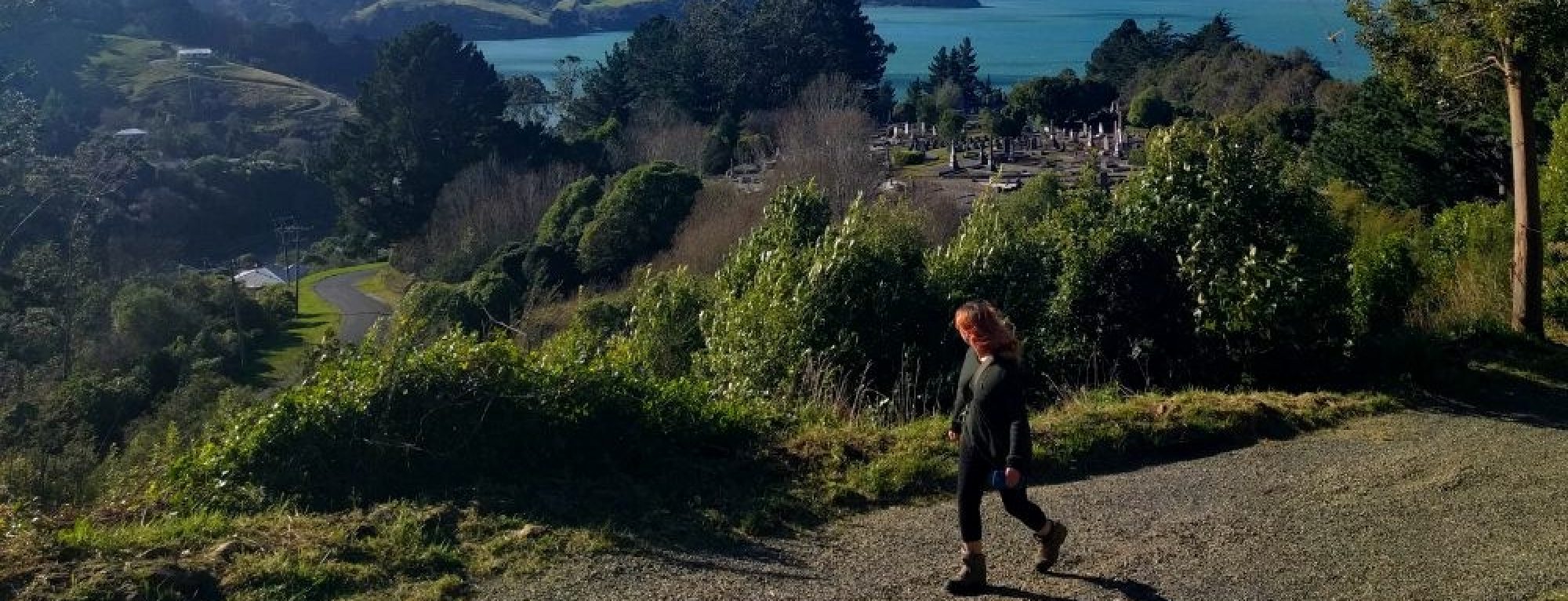



Kia ora. I appreciated this article very much. Stewart was my grandfather’s younger brother. As you say Stewart was killed and Gallipoli whereas Sydney Karetai returned. I would like to be able to share this article with my whanau if you would please allow.
Ka mihi mahana
Janine Karetai
Hi Janine, I’m glad you liked the article. Please feel free to share it 🙂
Re “Pudney’s Cliff”. Joseph Pudney (my gt-gt-grandfather) was a member of William Kettle’s team in the survey of Port Chalmers in 1846.